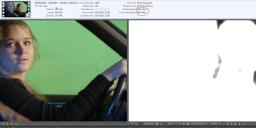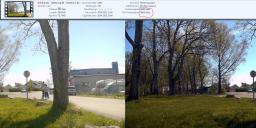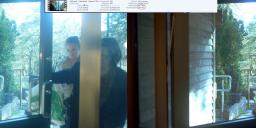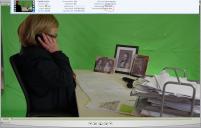
-
Check FAQs at http://www.personal-view.com/faqs
Check latest PTool topic http://www.personal-view.com/talks/discussion/2712/ptool-v3.65d-topic
Be sure to check all other topics with "beginners:" in their title.
Previous topic: http://www.personal-view.com/talks/discussion/443/beginners-basic-hacks-questions
-
Greetings!
I have a couple of questions about workflow.
So far, my workflow has been to shoot 1080p24, offload footage onto mac g5, convert footage via clipwrap to prores 1080p24, convert with compressor to 720p24 dvcprohd, and edit.
Recently, I've hacked my camera to the Sanity 4.1 patch. It's quality has improved; file sizes are much larger / record time has decreased, but all in all, I'm happy with the results.
My question is: going from .mts file to .mov (prores), do I lose quality? That is to say, if I were able to edit / grade raw files, would I have higher quality results than if I transcode to prores (and ultimately dvcpro). Clearly, downrezing to a 720 frame I lose resolution, but as far as color grading goes, what is the trade off to transcoding to prores and editing / grading in that format?
-
This has probably been asked a million times on here. But anyway; What exactly is GOP? How does it affect my GH2 video performance?
Also, bechou, when I hovered (or maybe I clicked) my cursor over the 'A' 'B' 'C' 'D'... settings buttons along the bottom of the PTools software, I think it said something about merging, but don't take my word for it, I just got my GH2 body 2 days ago, and did my first patch today.
I'm also interested in learning how exactly Vitaliy_kiselev accesses the code of the GH2 OS, I have done some programming before, and I'm interesting in trying to look around and see how it works - I'm still much in my learning stages of programming.
Any answers and advice would be greatly appreciated.
-
Hi Guys,
Loving the GH2 hack, but I've had a few issues with certain versions crashing the camera.
I'm looking for an absolutely stable, spanning and good for 25p 1080 version. I can't have the camera crashing in front of clients or heaven forbid losing footage. Any advice?
I've got Sandisk 30mb/s 8GB cards.
Thanks a lot, Jon
-
I just put only the .bin hack file on a slow and cheap 512MB SD card. I just wanted to make sure that it would be ok to install the new hack firmware with that SD card. It dosen't have to be a Class 6 or 10, correct? Don't want to take any chances on bricking the camera.
-
I have seen many reports here that the Sandisk 95MB/s 64GB card is the most reliable at demanding settings. I think I have also read that another size Sandisk 95MB/s card is slower or less reliable even though it is rated 95MB/s.
For short clips, and very limited storage needs (ie long record times not needed), would an 8GB Sandisk 95MB/s card be likely as fast/reliable for demanding settings as the 64GB card?
-
I'm also a beginner but gained some knowledge by reading & viewing the past few weeks.
@INERTIA GOP = Group of Pictures (default for the GH2 = 6, meaning 6 frames in one group of pictures. It consists of one I-frame (intra frame), B and P frames, wiki http://en.wikipedia.org/wiki/Group_of_pictures ). I also have a question about this though, if one shoots 24p, does that mean it has 24 : 6 = 4 'GOPs' ? Meaning: every frame from the 24 frames per second, is either an i, b or p frame?
@Jon2323 Check out the vids and links by mspgxd (excuse the spelling), he has settings which are absolutely stable.
@stevenjulien to install the hack it's alright to use a slow card, but when really shooting you might want to use an other card (unless you use the no adverse settings, again see mspgxd).
-
eyebox, ProRes is a lossy format, so yes, you do lose something by converting to ProRes. If the bit rate is high, you won't lose much. You'd lose nothing by staying in MTS format or working uncompressed video. But I doubt you'll notice the difference.
sangye, the GH2 can't do 1080/60p.
bechou, merging settings for different modes is possible in some cases for which the patch parameters are completely separate or identical. It's not for the faint of heart. 720p and 24p is one pair for which all of the settings are separate.
Intertia, a GOP is a group of pictures. It's a series of consecutive frames, where the first frame in the GOP is encoded in a self-contained way, without referencing any other frames (like the way a JPEG file is self contained). The self-contained frames are intra-coded - I-frames. Other frames in the GOP are coded with references to earlier or later frames, so that they can be coded more efficiently by taking advantage of the similarity between frames. They're called predicted frames - P-frames and B-frames. Generally, you needn't be concerned with GOP length, except to know that longer GOPs are more efficient (that is, greater image quality for a given bit rate, or a lower bit rate for the same quality), the difference in efficiency being greater when the frames are more similar. On the GH2, the choice of GOP length affects the highest bit rate that the encoder settings will span with. Also, due to the way the GH2's encoder works, B-frames and P-frames won't be encoded in exactly the same way as I-frames, leading to some frame-to-frame inconsistently. Intra-only settings (GOP length of 1) avoid that inconsistency.
I'm glossing over the fact that technically in h.264 I-frames can reference previously coded frames, and IDR frames can't, and really the h.264 spec defines I P & B for slices, not for frames, and that there are sub-types of all of these, and that a frame is not always a picture.
Vitaliy hacked the GH2 by breaking the firmware encryption and reverse engineering the firmware code. He has not made the encryption algorithm nor the decrypted code public. If you want to dig into his work, you better be as smart as he is.
stevenjulien, card speed does not matter for flashing the camera.
john2323, go through the Hacks category and see what people have come up with. Some guys claim high reliability for their settings. Some settings live up to the claims. Just look at the user reports. http://personal-view.com/talks/categories/hacks
Bressonftw, the GH2's default GOP length depends on the mode. It's not 6. It's 2 GOPs per second in most modes, or 50/24 GOPs per second in PAL modes. In 24p, the default GOP length is 12 frames. Every frame is an I-, P-, or B-frame.
bmcent1, the SanDisk Extreme Pro 95 MB/s 64-GB card is the fastest card in the GH2 with respect to stability and spanning. The 95 MB/s 32-GB card is the second fastest. If you don't care about spanning, all SanDisk Extreme cards will perform similarly in the GH2. There is little reason to buy a 95 MB/s card smaller than 32 GB.
-
Thank you @balazer!
I'm assuming you mean all 95MB/s Sandisk cards not "all SanDisk Extreme" cards because I do have some Extreme labeled cards that are only 30MB/s and occasionally experience unable to write errors with Sedna C.
For now I've switched back to GOP3Zilla with Sedna and that's been very stable for me. If I move up to Sedna or the newest XY Canis Majoris I will get my hands on a 95MB/s card.
I will either look for a 32GB card or go for a 8 GB 95MB/s card. I record short clips so spanning isn't needed and it's pretty rare that I put more than 4 to 8 GB on a card. The price difference right now is $30 vs $77 for 8GB vs 32GB 95MB/s card.
-
@Balazer Do you know if there is any schema with the amount of seconds/minutes to be filmed before it reaches 4 Gigabyte? Like: if you use this patch, the camera will span at X length. Or can you give a small indication perhaps?
But if you don't necessarily need to span, might one as well do the job with a 30 MB/s Sandisk extreme card?
-
Also, are there generally accepted settings on the LCD light & color? I've noticed the screen on the LCD is darker, has less shadow detail than perhaps the image really has.
-
Hi,
I wanted to go back to the original Panasonic 1.1 firmware just for comparison, but wasn't able to. I was told that I had to downgrade to Panasonic 1.0 first and then 1.1 and it would work. But, I can't find 1.0 online anywhere.
Vitaly says that downgrading to 1.0 first is idiotic. So, now I'm confused. How does one go back to 1.1? I just want it for safe keeping!
-
I think this had been answered about 100 times. Load firmware in PTool and do not touch anything (I mean patches), save firmware to other file. Load in camera. Period.
-
for some reason when i put my camera in c3, c2 or c1 i can change the appature like when its in M movie mode like in the 2nd video also my mic only works sometimes
-
Bressonftw, each of the different encoder settings will yield different bit rates in different modes under different conditions. I cannot generalize, but here is a bit of math to help you: divide 143 by the bit rate in Mbps. That gives you minutes per gigabyte. Multiply that by 4 to know how many minutes you'll get before spanning. Or multiply it by the card's capacity (e.g. 30 for a nominally 32-GB card) to know how many minutes the card will hold.
-
hello im having a problem with the |GH2 Setup guide| im attaching this video so someone can see what im having a problem on.
-
@filmsource just read the manual, your "problems" are so basic, first things first, en that is read TFM!!
And then after you understand the GH2, you may thinking off hacking your GH2........ -
Hello, I am having some trouble with hacking my cameras. It seems even though the hack is successful, the encoder still chooses to encode the video at a really low bitrate - which introduces artifacts. I have posted this question before, but I was directed to post it here with example.
The video looks fine, but as soon as I try to key out the green ( or do other stuff like grading, color correction ++) I see some horrid artifacts. Upon investigating I found that the bitrate for the video was only 9mbit - not the 75mbit that I hacked it with. This clip used the 75mbit peak reliability patch. It is filmed in 720p50 AVCHD. I used standard film mode -2,-2, 0,-2. The card used was a 16GB Sandisk Extreme HD Video Class 10 30MB/S. It is shot on a GH1.
As you can see in the picture, the key I get from the screen shows how awful the artifacts are. In this example I need the semi transparent key to preserve the reflection on the window. I used the same technique described by Andrew Kramer on his car tutorial on videocopilot.net. He used a Canon 5d and did not experience this kind of artifacts.
I hacked the camera using the procedures described in the documentation provided on this site. The procedure seems to have been done successfully. I also checked the footage in streamparser software and it to reports the low bitrate.
Any help would be appreciated.

 greenscreen-low-bitrate.jpg2580 x 720 - 262K
greenscreen-low-bitrate.jpg2580 x 720 - 262K -
Different hack settings generate different bit rates under different conditions. Shooting in 720p on the GH1, you might not be able to force the bit rate any higher under conditions such as these where there isn't a lot of detail in the scene. Test your camera on a detailed scene to be sure the hack worked and is generating high bit rates. GH2 hacks on a GH2 might get you more.
-
From the different scenes I have shot with this hack, the most I have gotten out of it was a landscape scene, with a lot of windy leaves. This scene I got 19mbit. Also I added a grab from a 1080p25 scene that also got 19mbit. Both of these scenes I experienced freezes and crashes, and they took a lot of takes to get down. It seems that once the encoder pushes 20mbit both my cameras start to get unstable. But as you can see in the last example the MJPEG mode has no problem giving me high bitrates. I would use that if I could get by with 30p - but I cannot.

 lowbitrate.jpg2580 x 720 - 648K
lowbitrate.jpg2580 x 720 - 648K
 lowerbitrate.jpg3855 x 1080 - 900K
lowerbitrate.jpg3855 x 1080 - 900K
 mjpeghigh.jpg1552 x 989 - 311K
mjpeghigh.jpg1552 x 989 - 311K
Howdy, Stranger!
It looks like you're new here. If you want to get involved, click one of these buttons!
Categories
- Topics List23,993
- Blog5,725
- General and News1,354
- Hacks and Patches1,153
- ↳ Top Settings33
- ↳ Beginners256
- ↳ Archives402
- ↳ Hacks News and Development56
- Cameras2,368
- ↳ Panasonic995
- ↳ Canon118
- ↳ Sony156
- ↳ Nikon96
- ↳ Pentax and Samsung70
- ↳ Olympus and Fujifilm102
- ↳ Compacts and Camcorders300
- ↳ Smartphones for video97
- ↳ Pro Video Cameras191
- ↳ BlackMagic and other raw cameras116
- Skill1,960
- ↳ Business and distribution66
- ↳ Preparation, scripts and legal38
- ↳ Art149
- ↳ Import, Convert, Exporting291
- ↳ Editors191
- ↳ Effects and stunts115
- ↳ Color grading197
- ↳ Sound and Music280
- ↳ Lighting96
- ↳ Software and storage tips266
- Gear5,420
- ↳ Filters, Adapters, Matte boxes344
- ↳ Lenses1,582
- ↳ Follow focus and gears93
- ↳ Sound499
- ↳ Lighting gear314
- ↳ Camera movement230
- ↳ Gimbals and copters302
- ↳ Rigs and related stuff273
- ↳ Power solutions83
- ↳ Monitors and viewfinders340
- ↳ Tripods and fluid heads139
- ↳ Storage286
- ↳ Computers and studio gear560
- ↳ VR and 3D248
- Showcase1,859
- Marketplace2,834
- Offtopic1,320








